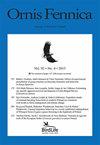供应洞穴筑巢鸟类的夜间沉思行为是成年捕食风险和筑巢体温调节需求之间的权衡
IF 1.2
4区 生物学
Q2 ORNITHOLOGY
引用次数: 1
摘要
在洞穴筑巢的鸟类中,雏鸟的夜间孵化会给父母带来捕食的风险。有趣的是,已知一些物种在后代发育过程中从持续的成虫夜间孵蛋行为转变为夜间无人照看雏鸟,但变化的时间、速度、父母之间的性别差异以及形成这种行为的因素很少被描述。此外,成虫在饲养雏鸟时使用的夜间栖息地的位置和性质很少受到研究的关注。我们研究了普通椋鸟Sturnus vulgaris的繁殖,并假设,在这样一个洞穴筑巢的物种中,1)雏鸟只在夜间孵化,直到它们达到热独立;2)由于该物种通常是一夫多妻制的,尽管两性都提供食物,但雌性父母很可能只在夜间孵化后代;3)夜间孵化更可能在温度最低的夜晚进行。在8个燕鸥巢的夜间视频记录以及18只燕鸥在26个夜晚的gps记录仪的数据支持了假设1)和2),而我们没有发现假设3)的支持。所有标记的雄性燕鸥总是远离筑巢地点(高达8公里),与雏鸟年龄无关;通常在孵化后的前7 - 9天(当雏鸟达到体温调节时),所有的雌性都在孵雏鸟,但在第10天之后,所有来自同一筑巢“群体”的标记椋鸟都在一起栖息。这些结果证实了与性别相关的父母在供养欧椋鸟方面的不同努力,表明雌性只在夜间产卵,直到幼鸟达到同源性。本文章由计算机程序翻译,如有差异,请以英文原文为准。
Night-brooding behaviour in provisioning cavity-nesting birds is a trade-off between adult predation risk and nestling thermoregulation needs
Night-brooding of nestlings in cavity-nesting avian species carries predation risks to parents. Anecdotally, several species are known to shift from constant adult night-brooding behaviour to leaving nestlings unattended at night during offspring development but the timing, speed of change and sex-specific differences between parents, and the factors shaping this behaviour have rarely been described. Moreover, the location and nature of night roosts used by adults whilst provisioning nestlings has received little research attention. We studied breeding Common Starlings Sturnus vulgaris and hypothesised that, in such a cavity-nesting species, 1) nestlings would only be night-brooded until they achieved thermal independence, 2) since the species is frequently polygynous, female parents would most likely exclusively night-brood offspring despite provisioning by both sexes and 3) night-brooding would be more likely during nights with lowest temperatures. Nightly video recordings throughout the nestling phase at eight Starling nests together with data from 18 Starlings fitted with GPS-loggers during 26 nights provided support for hypotheses 1) and 2), while we found no support for hypothesis 3). All tagged male Starlings always roosted far from the nesting site (up to 8 km) independent of nestling age; all females brooded nestlings, usually up to the first seven-nine days after hatching (when the nestlings achieve thermoregulation), but roosted with males after day 10, when all tagged Starlings from the same nesting ‘colony’ roosted together. These results confirm differential sex-related parental effort in provisioning Starlings, suggesting females only night-brood until young achieve homeothermy.
求助全文
通过发布文献求助,成功后即可免费获取论文全文。
去求助
来源期刊

Ornis Fennica
生物-鸟类学
CiteScore
2.00
自引率
0.00%
发文量
14
审稿时长
>12 weeks
期刊介绍:
Ornis Fennica is a peer-reviewed international ornithological journal published by BirdLife Finland. Ornis Fennica publishes analytical and experimental papers on the ecology, behaviour and biogeography of birds. Ornis Fennica prefers studies concerning Fennoscandian species, but other novel contributions of general interest are most welcome as well.
Ornis Fennica is an open-access journal without page charges for publication. All published articles (from 1924 onwards) are freely available from the journal website. First decisions are usually made within three months of submission.
 求助内容:
求助内容: 应助结果提醒方式:
应助结果提醒方式:


